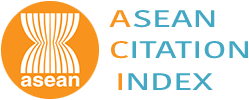Effect of 3-Day Storage and Temperature on ADP-induced Platelet Aggregation
Abstract
Objective: To observe platelet functions during the 3 days of platelet storage and to evaluate the effect of storage temperature towards platelet aggregation response.
Methods: Two conditions of platelet storage were used in this study: at room temperature and in a cold condition at 4 °C to observe the temperature effect on platelet aggregation. The aggregation test was performed using a 96-wells plate platelet aggregation method.
Results: At room temperature on day 1, the response of platelet aggregation reduced to 34.9±10.6%, which was less than half of the aggregation of fresh platelet (100%). The aggregation on day 2 reduced modestly (26.8±4.2%), in comparison with that seen on the first day. On day 3, platelet aggregation deteriorated significantly (6±1.2%), which was comparable to the control group without the presence of platelet agonist (6.1±1.4%). When platelets are stored at 4 °C, the aggregation response to ADP stimulation was slightly different to that shown by platelets stored at room temperature (22 °C). At the 4 °C, the aggregation response was 68.11±34.2%, 57.1±21.4%, and 5.9±2.6% at day 1, day 2, and day 3, respectively. The result showed that storing the blood at 4 ˚C or room temperature was not able to preserve platelet function, as the deterioration of platelet aggregation response over time was still taking place. Although was not statistically significant, our result indicated that cold storage reduced platelet responsiveness toward ADP activation.
Conclusions: This current study provides evidence of the deterioration of platelet function during first 3 days of platelet storage. Moreover, we found that storing platelets in 4 °C showed no significant benefit in preserving the ADP-induced platelet aggregation capacity compared to that stored in 22 °C.
Keywords: Adenosine diphosphate, platelet, platelet aggregation, platelet
storage
DOI: 10.15850/ijihs.v6n2.1375
Keywords
Full Text:
PDFReferences
Ohto H, Nollet KE. Overview on platelet preservation: Better controls over storage lesion. Transfus Apher Sci. 2011;44(3):321–5.
Tynngård N. Preparation, storage and quality control of platelet concentrates. Transfus Apher Sci. 2009;41(2):97–104.
Zhang JG, Carter CJ, Culibrk B, Devine DV, Levin E, Scammell K, et al. Buffy‐coat platelet variables and metabolism during storage in additive solutions or plasma. Transfusion. 2008;48(5):847–56.
Nair PM, Pandya SG, Dallo SF, Reddoch KM, Montgomery RK, et al. Platelets stored at 4 degrees C contribute to superior clot properties compared to current standard-of-care through fibrin-crosslinking. Br J Haematol. 2017;178(1):119–29.
Bynum JA, Adam M, Getz TM, Rodriguez AC, Aden JK, Cap AP, et al. Bioenergetic profiling of platelet mitochondria during storage: 4 °C storage extends platelet mitochondrial function and viability. Transfusion. 2016;56(Suppl 1):S76–84.
Yang J, Yin W, Zhang Y, Sun Y, Ma T, Gu S. et al. Evaluation of the advantages of platelet concentrates stored at 4 °C versus 22 °C. Transfusion. 2018;58(3):736–47.
Thon N, Schubert P, Devine DV. Platelet storage lesion: a new understanding from a proteomic perspective. Transfus Med Rev. 2008;22(4):268–79.
Egidi MG, D’Alessandro A, Mandarello G, Zolla L. Troubleshooting in platelet storage temperature and new perspectives through proteomics. Blood Transfus. 2010;8(Suppl 3):73–81.
Villarroel JPP, Figueredo R, Guan X, Tomaiuolo M, Karamercan MA, Welsh J, Selak MA, et al. Increased platelet storage time is associated with mitochondrial dysfunction and impaired platelet function. J Surg Res. 2013;184(1):422–9.
Bakry R, Sayed D, Galal H, Shaker S. Platelet function, activation and apoptosis during and after apheresis. Ther Apheres Dialysis. 2010;15(5):457–64.
Baimukanova G, Miyazawa B, Potter DR, Gibb SL, Keating S, Danesh A, et al. The effects of 22 0C and 4 0C storage of platelets on vascular endothelial integrity and function. Transfusion 2016;56 (Suppl 1):S56–64.
Podda GM, Scavone M, Femia EA, Cattaneo M. Aggregometry in the settings of thrombocytopenia, thrombocytosis and antiplatelet therapy. Platelets [serial on the internet] 2018 Mar [cited 2018 Jul 12];14(1):[about 6p.]. Available from:https://www.tandfonline.com/doi/abs/10.1080/09537104.2018.1445843?journalCode=iplt20.
Michelson AD. Methods for the measurement of platelet function. Am J Cardiol. 2009;103(Suppl 3):S20–6.
Vinholt PJ, Nybo M, Nielsen CB, Hvas AM. Light transmission aggregometry using pre-coated microtiter plates and a Victor X5 plate reader. PloS one [serial on the internet]. 2017 OCt [cited 2018 Jan 20];12(10):[about 12p.]. Available from: https://journals.plos.org/plosone/article?id=10.1371/journal.pone.0185675.
Dumont LJ, AuBuchon JP, Whitley P, Herschel LH, Johnson A, McNeil D, et al. Seven-day storage of single-donor platelets: recovery and survival in an autologous transfusion study. Transfusion. 2002;42(7):847–54.
Akay OM, Gündüz E, Başyiğit H, Gulbas Z. Platelet function testing during 5-day storage of single and random donor plateletpheresis. Transfus Apheres Sci. 2007;36(3):285–9.
Reddoch KM, Pidcoke H, Montgomery RK, Fedyk CG, Aden JK, Ramasubramanian AK, et al. Hemostatic function of apheresis platelets stored at 4 degrees C and 22 degrees C. Shock. 2014;41(Suppl 1):54–61.
Shrivastava M. The platelet storage lesion. Transfus Apheres Sci. 2009;41(2):105–13.
Braune S, Walter M, Schulz F, Lendlein A, Jung F. Changes in platelet morphology and function during 24 hours of storage. Clin Hemorheol Microcirc. 2014;58(1):159–70.
Diab A, Thomas A, Luban NLC, Wong ECC, Wagner SJ, Levy RJ. Acquired cytochrome C oxidase impairment in apheresis platelets during storage: a possible mechanism for depletion of metabolic adenosine triphosphate. Transfusion. 2012;52(5):1024–30.
DOI: https://doi.org/10.15850/1375
Article Metrics
Abstract view : 843 timesPDF - 297 times
This Journal indexed by

IJIHS is licensed under a Creative Commons Attribution-NonCommercial 4.0 International License
View My Stats





